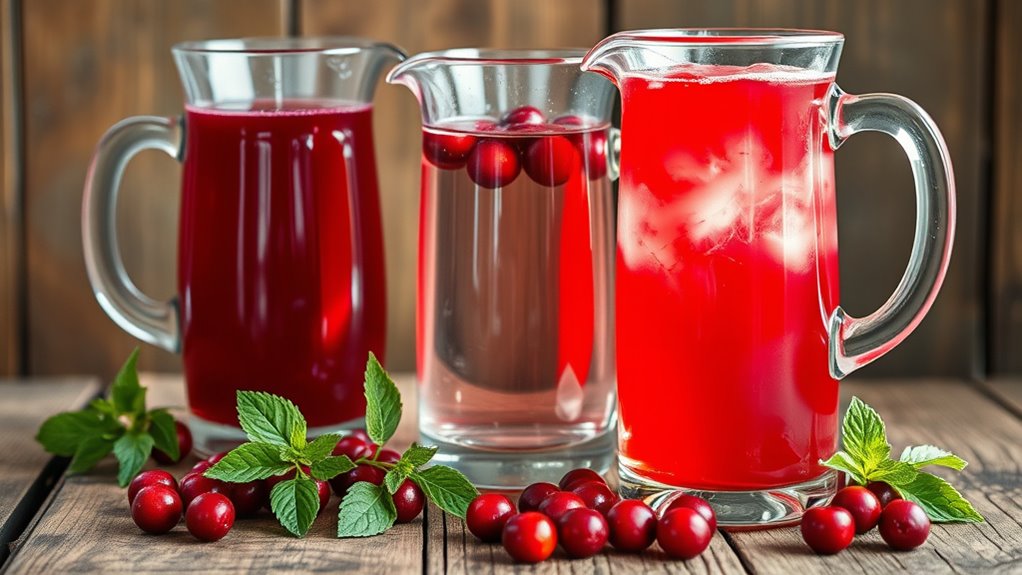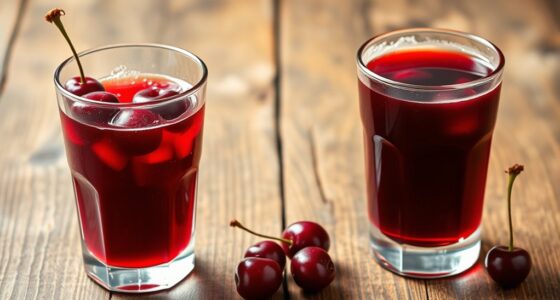When choosing cranberry juice, you’ll find three main types: unsweetened, which contains no added sugars and offers the most health benefits, sweetened versions that may have sugars or artificial sweeteners, and blends combining cranberries with fruits like apple or grape for a milder taste. Each type has pros and cons depending on your health goals and flavor preference. To get the most out of your juice, learning about these options can help you select the best fit for you.
Key Takeaways
- Unsweetened cranberry juice contains no added sugars, maximizing health benefits, while sweetened versions may include added sugars or artificial sweeteners.
- Blended cranberry juice combines cranberries with other fruits like apple or grape, often affecting flavor and sugar content.
- Always review ingredient labels to identify added sugars or artificial ingredients in sweetened or blended juices.
- Unsweetened cranberry juice is ideal for those seeking maximum health benefits and minimal sugar intake.
- Lightly sweetened options can be a compromise but should still be checked for added sugars and additives.

Have you ever wondered why cranberry juice is a popular choice for health-conscious consumers? It’s mainly because of its impressive health benefits. Cranberries are packed with antioxidants, vitamins, and nutrients that support your immune system, promote urinary tract health, and may even help reduce inflammation. Drinking cranberry juice can be an easy way to incorporate these benefits into your daily routine. However, not all cranberry juices are created equal. Some are sweetened, some are unsweetened, and others are blends of different fruit juices. Understanding these options helps you make better choices that align with your health goals.
When choosing cranberry juice, especially if you’re aiming to maximize health benefits, unsweetened varieties are often the best option. These contain no added sugars, so you get the pure, natural benefits of cranberries without excess calories or artificial sweeteners. If you prefer a sweeter taste, you might opt for a lightly sweetened version, but it’s important to check the label for added sugars. Too much sugar can negate some of the health benefits and contribute to weight gain or other health issues. Blended cranberry juices, which combine cranberries with fruits like apple or grape, can be a tasty alternative, but again, scrutinize the ingredient list to avoid added sugars or artificial flavors.
Proper storage tips are essential to preserve the quality of your cranberry juice. Once opened, keep it refrigerated and tightly sealed to prevent spoilage and contamination. Cranberry juice typically stays fresh for about 7 to 10 days in the fridge, so try to consume it within that timeframe. If you buy in bulk or want to store it for longer, consider freezing portions in ice cube trays or airtight containers. Freezing not only extends its shelf life but also helps maintain the juice’s nutritional integrity. Always check for signs of spoilage, such as an off smell, mold, or changes in color or texture, before drinking. Proper storage guarantees you get the maximum health benefits from your cranberry juice without risking any health issues.
Frequently Asked Questions
Are There Any Health Risks Associated With Consuming Cranberry Juice?
Yes, there are health risks when you consume cranberry juice. If you drink sweetened versions, you might increase your sugar intake, affecting weight management and possibly leading to weight gain. Excessive consumption can also interact with certain medications, especially those related to blood thinning, similar to some alcoholic beverages. Always opt for unsweetened or blended cranberry juice and consume in moderation to minimize risks and enjoy its health benefits safely.
How Does Cranberry Juice Affect Dental Health Over Time?
Drinking cranberry juice regularly can impact your dental health by promoting dental erosion due to its acidity, which wears down enamel over time. It also affects oral bacteria, as the natural compounds may help reduce harmful bacteria that cause cavities and gum disease. However, if you consume it frequently or drink sweetened versions, you risk increased erosion and bacterial imbalance. Rinsing your mouth afterward can help minimize these effects.
Can Cranberry Juice Help Prevent Urinary Tract Infections?
You can help prevent urinary tract infections by drinking cranberry juice, as studies show it reduces the risk by about 40%. Cranberry extract contains compounds that inhibit bacteria from attaching to urinary tract walls, promoting urinary health. Regular consumption, especially of unsweetened or blended options, may be beneficial. Just remember, while cranberry juice supports urinary health, it shouldn’t replace medical treatment if infections occur.
What Are the Environmental Impacts of Cranberry Juice Production?
You should know that cranberry juice production impacts the environment through water usage and sustainable farming practices. Growing cranberries requires significant water, which can strain local resources if not managed properly. However, many producers adopt sustainable farming methods to reduce water waste and preserve ecosystems. By choosing brands committed to eco-friendly practices, you help support responsible production, minimizing environmental harm while enjoying your favorite cranberry juice.
Does the Sugar Content Vary Significantly Between Brands?
Sure, brand variations in cranberry juice mean some are practically dessert, loaded with added sugars, while others stay true to nature with little to no sweetness. You might think, “Oh, it’s just juice,” but the reality is, some brands sneak in enough added sugars to turn your health goal into a sugar binge. So, check labels carefully—your taste buds and waistline will thank you for it.
Conclusion
Remember, you are what you drink. Whether you choose sweetened, unsweetened, or blended cranberry juice, make mindful choices that nourish your body. While the saying “An ounce of prevention is worth a pound of cure” holds true, incorporating cranberry juice can support your health in small but meaningful ways. Trust your instincts, enjoy your favorite type, and prioritize your well-being—because your health is worth every mindful sip.
Cindy thoroughly researches juicing trends, techniques, and recipes to provide readers with practical advice and inspiration. Her writing style is accessible, engaging, and designed to make complex concepts easy to understand. Cindy’s dedication to promoting the advantages of juicing shines through her work, empowering readers to make positive changes in their lives through the simple act of juicing.











